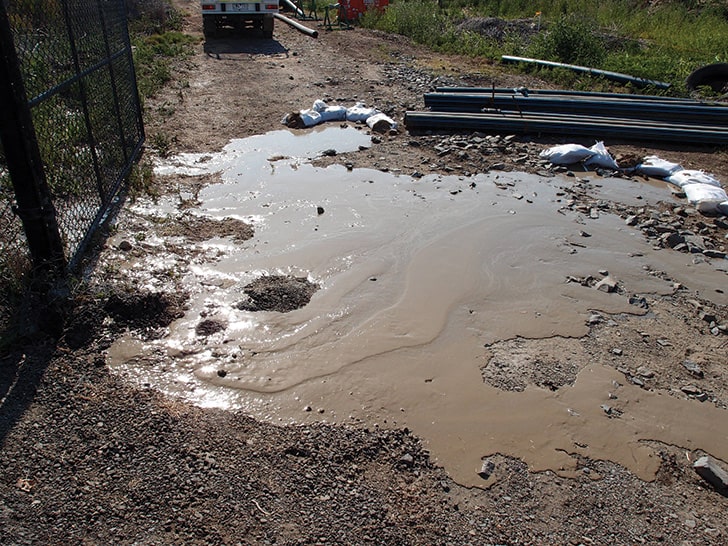The utility industry is regularly required to call on an enormous and varied range of specialists; from mapping, to drilling, to wastewater treatment, to asset management, to pipe relining, to pipeline integrity, to land access, to risk management, and the list goes on. To make the process a little easier, Utility magazine is bringing together experts from various fields to answer your questions.
What is a frac-out?
A ‘frac-out’ is the unintentional return of drilling fluids to the surface during horizontal directional drilling (HDD).
A frac-out occurs when the down hole mud pressure exceeds the overburden pressure (i.e. shallow or loose sections of the bore), or the fluid finds a preferential seepage pathway (such as fault lines and fractures, infrastructure or loose material).
These fractures can be natural or induced by overpressurising the formation.
It is relatively common for a frac-out to occur on a HDD project. Most frac-outs, however, are usually minor, within construction right of way (CROW) and close to the bore entry or exit.
How serious is a frac-out?
That all depends on where it occurs. If the frac-out occurs in an environmentally or culturally sensitive area (which you are generally trying to avoid by using HDD), there is reason for concern.
The drilling fluid itself may not be toxic, but the fine particles can smother plants and animals, particularly in an aquatic environment. If a saltwater polymer fluid is used, the salt can also impact on freshwater systems and terrestrial vegetation. Neighbouring landowners do not appreciate frac-outs on their land.
In most states a frac-out outside of the working area is generally considered a ‘reportable incident’. In Victoria all frac-outs must be reported to the regulator within two hours.
Frac-outs may also damage infrastructure or nearby services. There are reports of sections of roads rising, nearby water pipelines failing as the frac-out washed away the bedding sand, power boxes filling with fluid and vegetation disappearing into a sinkhole caused by a frac-out.
On the other hand, the frac-out may be small (less than 20L), occur within a disturbed or nonsensitive area and be easily contained and cleaned up. In these cases, there is no lasting impact or damage and no real reason for concern.
These frac-outs are still better avoided as they utilise resources and time in the cleanup and reporting.
Generally with frac-outs, the perception and association with other industries means the perceived threat is far worse than reality.

An area where a minor fracout has occurred, which has been cleaned up and no lasting damage is expected.
What can be done to prevent frac-outs?
The first step is to assess the risk of fracout prior to drilling. This can be done using speciallydesigned software (e.g. DGeo Pipeline by Deltares) or pressure calculations.
These methods compare the maximum allowable fluid pressure against the expected drilling fluid pressure.
To ensure they are reliable, they require detailed information on the soils, drilling fluids and bore profile, and should be conducted by experienced personnel.
The modelling will predict if and where fracouts are likely to occur, if profile changes are required (e.g. increasing the depth), the maximum drilling pressures (the driller can then set alarms at these pressures) and if other management strategies are required.
In some cases it may be necessary to install casing at the entry point where reduced cover and bearing pressure exists, or drill pressure relief wells to give the fluid a controlled place to go.
The modelling also allows for the optimum pilot hole bottom hole assemblies (BHA) to be configured for the formation, allowing the correct bit size to be selected for the drill pipe dimensions.
During drilling, contractors should continually monitor the drilling fluid properties i.e. mud weight, viscosity, gel strength, volume and pressure, to prevent frac-outs.
They can also include a pressure sub for real-time down hole pressure monitoring by the driller, allowing actual annular pressure readings to be obtained in real-time and then plotted against the modelled values.
If any unexpected variations or trends are observed then drilling should immediately cease and the cause investigated.
Common causes include a restricted or blocked annulus created by a build-up of cuttings which requires mechanical agitation and fluid flow to re-suspend and remove the blockage.
Contractors should be prepared with frac-out contingency plans and response equipment such as sand bags, vac-trucks and the like in place. Regular inspections should also be conducted along the drill path during pilot hole drilling.
Both the contractors and the client can take steps to prevent frac-outs, especially in sensitive areas, by undertaking adequate assessment and planning before drilling, and ensuring sufficient controls and monitoring are in place during drilling.
About Charles Stockton
UK-born Charles Stockton has been a part of the HDD sector in Australasia since 2003. He is the Managing Director of Stockton Drilling Services, a leading engineering consultancy specialising in HDD and other trenchless pipeline installation methods, with experience in managing projects throughout Australia.














